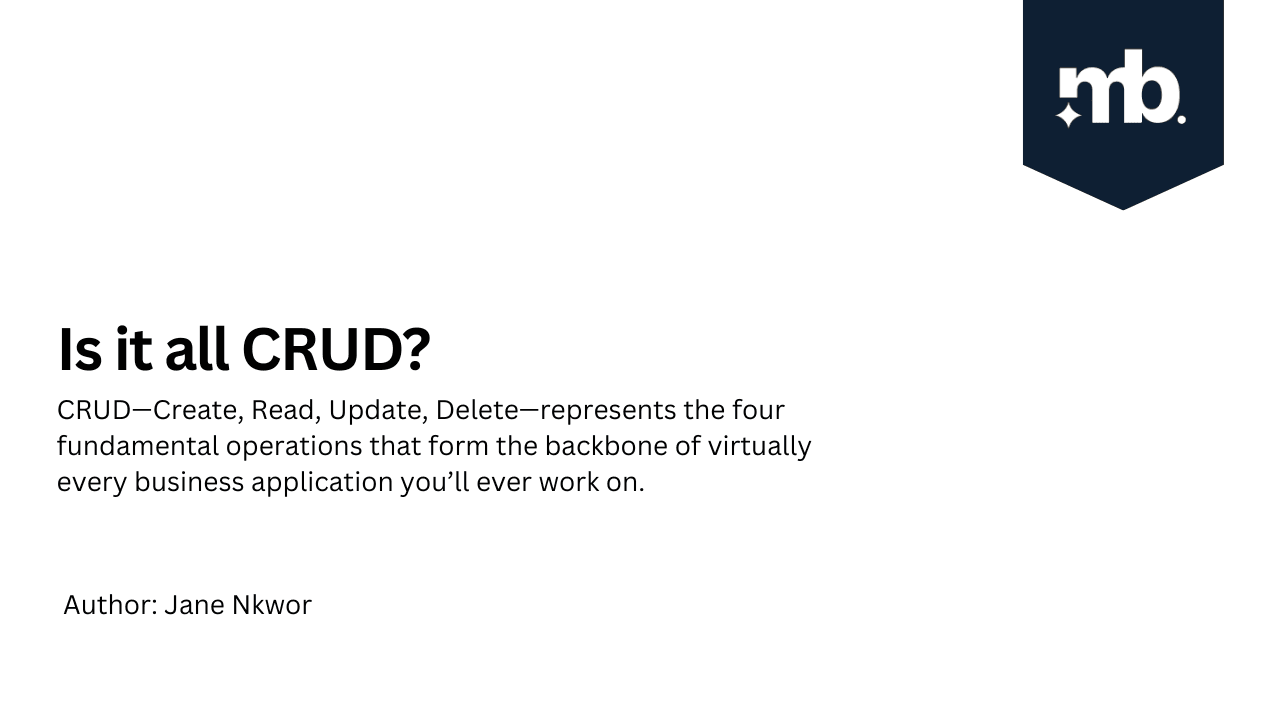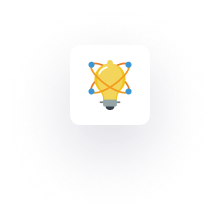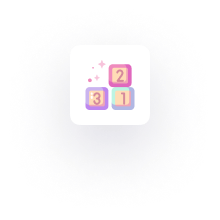What is the Reality of Modern Software Development?
A look at what software developers actually spend their time building
As you begin your development journey, you start to see that most of the features and functionalities you work on and will build are typically just CRUD (CREATE, READ, UPDATE, and DELETE). It presents in various forms and formats, but having a foundational understanding of how to CRUD in your chosen programming language takes most of the work that you would have to do when developing apps and software.
Suppose you’re just starting your journey in software development. In that case, you might be dreaming of building the next revolutionary AI system, creating groundbreaking algorithms, or architecting complex distributed systems that handle millions of concurrent users. While these exciting projects exist, here’s the reality check most experienced developers won’t tell you upfront: the vast majority of your career will be spent building CRUD applications.
CRUD Create, Read, Update, Delete represents the four fundamental operations that form the backbone of virtually every business application you’ll ever work on. And contrary to what you might think, this isn’t a limitation of the field; it’s actually its strength.
The Numbers Don’t Lie
Let’s start with some hard data. According to recent industry statistics, 84.7% of software development projects are focused on enterprise applications, with 53.6% specifically targeting business automation. What do you think business automation applications do? They manage data lots of it.
Think about it: every customer relationship management (CRM) system, every inventory management platform, every human resources application, every e-commerce site, and every content management system is fundamentally about creating, reading, updating, and deleting data.
What CRUD Really Means in Practice
CRUD operations are “the four basic operations (actions) of persistent storage” and are sometimes used to describe user interface conventions that facilitate viewing, searching, and changing information using computer-based forms and reports.
But let’s break down what this means in real-world applications:
Create: Every time a user signs up for an account, submits a form, uploads a file, or adds a product to their cart, you’re implementing Create functionality. This isn’t just about INSERT statements in a database it involves validation, error handling, user feedback, and often complex business logic.
Read: This is the most frequent operation users perform. Every search result, every dashboard, every report, every profile page, and every product listing is a Read operation. The complexity lies in performance optimisation, filtering, sorting, pagination, and presenting data in a meaningful way.
Update: When users edit their profiles, modify settings, update product information, or change their passwords, you’re handling Update operations. This often involves the most complex business logic, including permission checking, data validation, audit trails, and sometimes intricate workflow management.
Delete: Beyond simple deletion, this includes archiving, soft deletes, cascading deletions, and cleanup operations. Modern applications rarely permanently delete data immediately they mark it as deleted, archive it, or move it to different storage tiers.
The Enterprise Reality
If you’ve ever worked with a database-driven application, you’ve already interacted with CRUD operations whether you realised it or not. CRUD (Create, Read, Update, Delete) forms the backbone of most systems that rely on relational databases. These operations are incredibly versatile, powering vital functions across industries and business models.
Consider a typical energy management system. It might use a relational database to track customers, energy consumption, billing records, and maintenance schedules. Every interaction with this system logging a new customer, updating meter readings, viewing usage reports, or deleting outdated records is essentially a CRUD operation at work.
The same pattern repeats across industries:
Healthcare: Patient records, Appointment scheduling, Medical histories, Billing information
Education: Student information systems, Grade management, Course catalogues, Enrollment processing
Real Estate: Property listings (create/update/delete property details), Tenant and lease management, Maintenance requests, Agent and client records
Event Management: Event creation and updates, Ticket booking and attendee lists, Venue management, Speaker or performer scheduling
Hospitality & Tourism: Hotel room booking systems, Guest records and preferences, Restaurant menus and reservations, Tour package management
Why This Should Excite You, Not Disappoint You
Here’s where many beginners get it wrong they think CRUD is boring, simple or “not real programming.” This mindset misses the forest for the trees.
1. CRUD is Where the Money Is
Businesses need data management systems. That’s where most software jobs are, and that’s where companies are willing to spend serious money. The enterprise software market revenue is projected to reach $344.4 billion by 2027, with the majority of this revenue attributed to CRUD-based applications.
2. Complexity Lies in the Details
Building robust CRUD applications involves:
Security: Authentication, authorisation, input validation, SQL injection prevention
Performance: Database optimisation, caching strategies, efficient queries
User Experience: Intuitive interfaces, real-time updates, responsive design
Scalability: Handling growing data volumes and user bases
Integration: APIs, third-party services, legacy system compatibility
Reliability: Error handling, data consistency, backup and recovery
3. Every “Revolutionary” App Is Still CRUD
Instagram? Create posts, read feeds, update profiles, and delete photos. Netflix? Create viewing histories, read movie catalogues, update recommendations, and delete downloads. Uber? Create ride requests, read driver locations, update trip status, and delete payment methods.
The innovation isn’t in avoiding CRUD it’s in how elegantly and efficiently you implement it.
Mastering CRUD: Your Career Foundation
The goal of every developer is to become excellent at building CRUD applications and understanding how all the layers work together. Instead of chasing the latest framework or algorithm, focus on becoming exceptional at:
Database Design and Optimisation
Learn relational database principles, normalisation, indexing, and query optimisation. Understand when to use NoSQL alternatives and how to design schemas that perform well at scale.
API Design
Most modern CRUD applications are built with APIs. Master RESTful design principles, understand GraphQL, and learn how to build APIs that are secure, performant, and maintainable.
Security Best Practices
CRUD applications handle sensitive data. Learn about authentication, authorisation, input validation, and common vulnerabilities like SQL injection and cross-site scripting.
User Interface Design
The best CRUD applications have interfaces that make complex data management feel simple. Learn how to design forms, tables, search interfaces, and dashboards that users actually enjoy using.
Testing and Quality Assurance
CRUD applications often handle critical business data. Learn automated testing, understand different testing strategies, and develop practices that ensure data integrity.
Don’t feel constrained by the CRUD paradigm feel empowered by it. CRUD operations are the pillar of most data-driven applications, from e-commerce platforms to healthcare systems and enterprise software. When you master CRUD, you master the foundation of modern software development.
Conclusion
The next time someone tells you they’re working on “just another CRUD app,” remind them that they’re working on the backbone of the digital economy. Every successful business runs on data, and every data-driven application is fundamentally about creating, reading, updating, and deleting that data efficiently, securely, and elegantly.
Do not avoid building CRUD apps. Embrace the reality, master the fundamentals, and you’ll find that there’s more than enough complexity, creativity, and career opportunity in the world of CRUD applications.
Remember: it’s not “just” CRUD. It’s the foundation upon which the entire digital world is built.
References
MultiQoS. “Software Development Statistics And Trends 2025.”
MindInventory. “101+ Software Development Statistics You Should Know in 2025.”
Quora Discussion. “Are most websites just CRUD systems?”
Wikipedia. “Create, read, update and delete.”
Sumo Logic. “Discover what crud is | definition and overview.”
Budibase. “What is a CRUD App & How to Build One in 3 Steps.”
DronaHQ. “What is a CRUD app and how do you build one?”
Huntress. “What are CRUD Operations? CRUD Explained.”
Mastering Backend. Bookstore CRUD application with FARM stack



